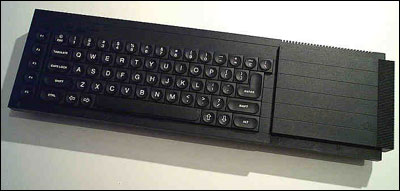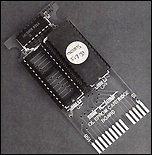|

After
its remarkable successes with the ZX81
and Spectrum,
it seemed that Sinclair Research could do
no wrong. Its next computer, the Sinclair
QL (or "Quantum Leap"),
was promoted as a revolutionary breakthrough
- the first 32-bit home computer,
costing under £400. Great things were
promised - reliable twin microdrives, multitasking,
networking, a proper monitor, a huge 128KB
of memory backed up by a Motorola 68008
processor. The optimistic mood was summed
up by Sinclair's television adverts, showing
a scarf-wearing Sir Clive leapfrogging over
a line of competitors' inferior products.
It
was not to be, however. The early promise
of the Sinclair QL was rapidly undone by
the disastrous technical and production
difficulties which the machine encountered
in its first months on the market. As had
happened on so many previous occasions,
Sinclair's delivery systems and quality
control were seriously deficient; frustrated
owners waited months for their machines
only to find, in many cases, that when they
eventually arrived they did not work properly.
 Even
those that did work initially came with
an unexpected addition: a "dongle"
(right),
a small board hanging out of the
rear of the machine, containing the ROM.
Sinclair's rush
to get the QL onto shop shelves meant that
the ROM had not been finalised when the
machine went on sale. As a result, it had
to be mounted on an external board - hence
the infamous dongle. Even
those that did work initially came with
an unexpected addition: a "dongle"
(right),
a small board hanging out of the
rear of the machine, containing the ROM.
Sinclair's rush
to get the QL onto shop shelves meant that
the ROM had not been finalised when the
machine went on sale. As a result, it had
to be mounted on an external board - hence
the infamous dongle.
Despite all the problems, the QL did manage to achieve sales
of 100,000, though this was far less
than Sinclair had hoped for given the machine's
specifications. The ZX81
and Spectrum
had, by comparison, sold millions. To some
extent, this was a result of the way in
which the machines were marketed. The ZX
machines were unashamedly aimed at the home
market and overwhelmingly used as games
machines. The QL, on the other hand, was
pitched very much at business users - the
number of commercially available games produced
for the machine was negligible.
But
Sinclair was unlucky in his timing. The
release of the non-PC compatible QL happened
to coincide with the rise of the Microsoft-Intel-IBM
standard. At the same time, the cost of
PC hardware (notably mass storage devices)
fell to a point where the QL's price advantage
was eroded. Within a couple of years, businesses
had adopted a standard setup - IBM-compatible
PCs running MS-DOS - and the market for
a non-standard business computer like the
QL simply vanished.
After
the 1986 takeover by Amstrad of Sinclair
Research's computer business, the QL was
quietly dropped. However, the QL's
technology survived for a while in a number
of different guises, notably as the ICL
One
Per Desk.
The
QL, however, had a much more lasting legacy
in a wholly unanticipated way. In the mid-1980s,
a young Finnish programmer named Linus Torvalds
upgraded from his VIC-20 to a Sinclair QL
to learn advanced programming. Years later,
he recalled:
[I] was eventually able
to get a Sinclair QL and get some real
programming done under a multitasking
(albeit somewhat weird) system.
On the Sinclair QL I continued
to program in assembly (the QL BASIC (SuperBasic)
was ok, but I wasn't interested), and
I wrote various more-or-less useless programs
(ranging from a FORTH compiler and an
editor-assembler system of my own to Pac-Man
to a MSDOS compatible floppy disk driver).
The QL was a fun machine, but there weren't
very many of them in Finland, and although
I was generally happy to write my own
programs (still am), it did teach me to
buy hardware that actually is supported.
[Linux
News issue 3, October 18-26 1992]
In March 1991, Torvalds
upgraded to a 386 PC, using the programming
knowledge which he had gained on the QL
to produce a cut-down version of the UNIX
operating system which he nicknamed Linux.
The rest, as they say, is history.

Back
to top
|